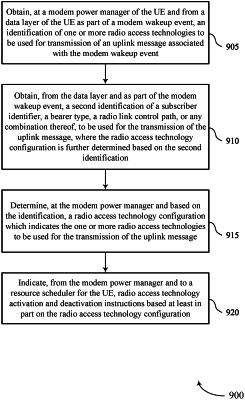| CPC H04W 52/0229 (2013.01) [H04W 52/0216 (2013.01); H04W 52/0274 (2013.01); H04W 84/12 (2013.01)] | 28 Claims |

|
1. A method for wireless communication at a user equipment (UE), comprising:
obtaining, at a modem power manager of the UE and from a data layer of the UE as part of a modem wakeup event that interrupts a sleep state of a discontinuous reception mode, an identification of one or more radio access technologies to be used for transmission of an uplink message whose arrival at the data layer of the UE prior to the transmission of the uplink message triggers the modem wakeup event;
determining, at the modem power manager and based at least in part on the identification, a radio access technology configuration which indicates the one or more radio access technologies to be used for the transmission of the uplink message;
indicating, from the modem power manager and to a resource scheduler for the UE, radio access technology activation and deactivation instructions based at least in part on the radio access technology configuration; and
transmitting the uplink message using the one or more radio access technologies indicated by the radio access technology configuration.
|